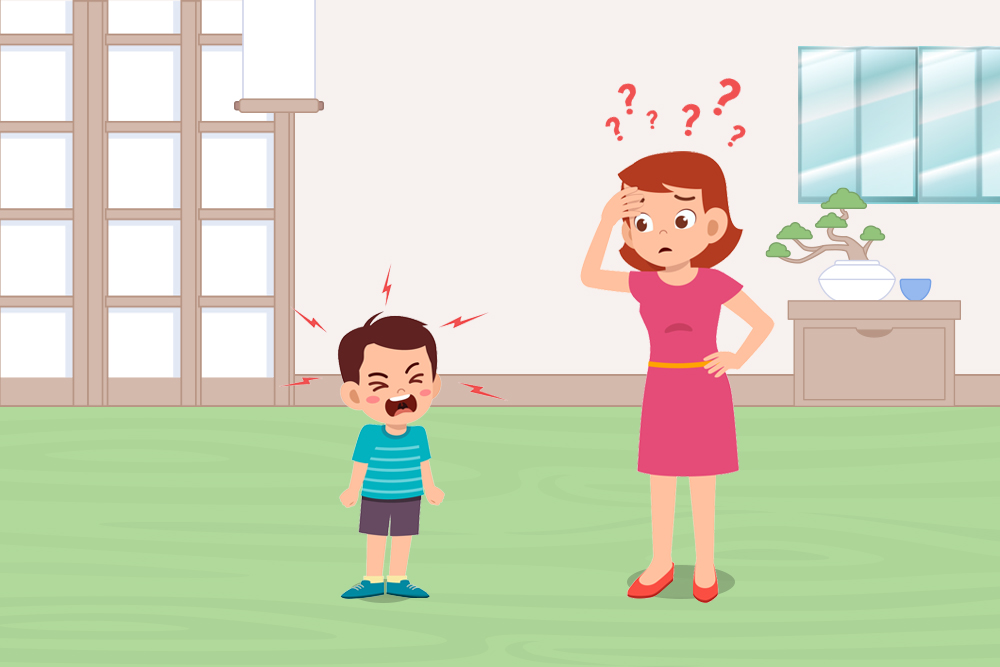
Have you ever wondered why young kids behave oddly or start acting frustrating?
Sometimes kids start behaving oddly, they get frustrated, angry and always yell and cry or hit anything, this situation is called a temper tantrum. Temper tantrums are very common and a natural behaviour problems among young kids.
This usually takes place between the ages of 1 to 3. Some kids face temper tantrums more, while others face them very little; it depends upon their needs, care, as well as the child’s behavior.
During temper tantrums, kids usually break things, scream, cry, hit objects, and yell at others, these are unique in both male and female kids. Tantrums are natural and a part of human development. Temper tantrums happen when a children feel hungry, tired or feeling uncomfortable.
Temper tantrums also happen when a child needs immediate parental attention or wants something. With time, children will be able to control their anger through discipline and understanding language and speaking skills.
Toddlers exhibit such behavior because they are unable to communicate their emotions with others, and older child tantrums show up because they haven’t learned how to express their emotions.
Contents
What Are Temper Tantrums?
Temper Tantrums can be defined as the odd behavior of toddlers between the ages of 1 to 3. This behavior includes screaming, kicking, falling, fleeing, yelling, uncontrollably crying, etc.
A tantrum may even cause some kids to throw or break objects, hold their breath, or even vomiting.
Tantrums can be both verbal and physical. In general, this makes children act out, cause trouble and behave in an unpleasant manner. In toddlers and preschoolers, temper tantrums are natural and a normal part of childhood development.
At this age, kids learn how to communicate their feelings and emotions and control frustration. However, there is nothing to be worried about it and parents can effectively help their kids to manage it.
How to Deal with Temper Tantrums?
Here are some of the ways on how to deal with temper tantrums like do not give in to demands, paradoxical instruction, stay calm, and act once the tantrum subsides.
1. Do Not Give in to Demands
It is vital to NOT give in to your child’s demands, just because the tantrum is putting you in an awkward situation.
Otherwise, soon the tantrums will become more of a psychological play where the child would deliberately throw a tantrum in public so that you agree to his/her demands, just to save face.
By not giving in to your child’s demands under such circumstances, you will be sending a clear signal that tantrums will not help them get what they want. Also, do not try to bribe your child to find a quick fix for the tantrum.
2. Paradoxical instruction
This may work wonders with some kids. Simply give them the permission to yell and scream as much as they want or until they’re ready to stop.
You could say, It’s OK if you shout loudly. Scream as much as you want, I won’t stop you. Once the child realises that you are unaffected by their behaviour, he/she may not see any point in it.
You can especially try this approach when you are in a big open space (like a park) since the noise will not bother anyone.
However, if you are in an enclosed space with a lot of people around, simply carry your child somewhere else so that others do not feel disturbed.
3. Stay calm
Tantrums can be agitating for the parents and often make them feel helpless. Most of us lose our patience and end up either spanking the child, yelling at the kid, or simply dragging our child away.
Displaying such behaviour does not really do any good and ends up leaving us exhausted instead. Try to stay quietly with your child during a tantrum and do not try to reason with him/her.
You may hold them or gently touch them or give them their space based on the situation. Try to speak to them in a low voice and continue doing whatever you were doing before the tantrum.
4. Act once the tantrum subsides
The conversation that you have with your child once the tantrum has passed is crucial. Do embrace your child and ask them to identify the emotion they were feeling.
This will help you understand the triggers for the tantrums and also make you more aware of the emotion that your child is struggling to express constructively.
Tell them how they could have handled the situation without getting all worked up. It is important to comfort your child because a tantrum not only takes a toll on the parents but is physically and mentally taxing for the child as well.
No matter how much you try to avoid a tantrum from coming, your child may still surprise you by displaying such seemingly irrational behaviour when you least expect it.
It is essential to be mentally strong while deal with temper. Remember that while you may not always be able to stop a tantrum from coming, you can try the above-mentioned ways to ensure that the experience is less stressful for everyone.
Ways to Prevent Tantrums
Temper tantrums are a natural process for overall development in kids, however, sometimes they can lead to trouble or chaos.
For parents, it becomes essential to control them with proper methods, as yelling at kids will only make things worse. To effectively manage the temper tantrums, you can check below.
1. Communicate Effectively:
Communication is very much essential for understanding each other’s feelings. Through communication, kids can share their feelings and emotions.
Also, as a parent, teach your kids how to stay calm, make sure that their needs are met, understand their small behaviors and act accordingly.
2. Create a Routine:
A time schedule is very much essential in promoting a routine life. Toddlers who follow a regular daily schedule are less anxious and less likely to have temper tantrums because they know what to expect and when to expect.
Time schedule also helps kids to be mentally prepared and promotes cognitive development among students .
3. Spend Time:
Spending quality time with kids is one of the best way to handle tantrums. Regular spending time with your kids will strengthen the parent-child relationship and help them get attention.
Even praising and rewarding for good activities will help in boosting positive behaviors as well as strengthening emotional well-being.
4. Teach Calming Behaviour:
One of the effective ways to manage temper tantrums in kids is by teaching them how to stay calm. Teach them how to control frustration and stay calm even in negative situations.
This will help kids understand how to control their feelings. Teaching children deep breathing, meditation and, counting numbers will help to cope with frustration and anxiety.
5. Give Choices:
Young children learn from observation and others. As a parent, it becomes essential to give your child choices or empowerment. For example: Give them choices of what they want to wear, or what colour they like.
This will help them in developing senses and choice power. As a parent, it is essential to avoid unnecessary things, and help you toddler to explore the possibilities.
6. Don’t Yell at your Kids:
Yelling is one of the worst things one can do to control temper tantrums. Yelling will only create negative effects on kids.
Yelling will develop hate among kids, and will feel unsafe, and negatively affect the parent-child relationship. Instead of yelling, try to keep your kid calm, communicate with them, and give love and affection.
7. Always Stay Ahead:
Always understand the reasons for kids’ tantrums. Mostly, the reason for tantrums is hunger and needs.
So, as a parent, it is essential to plan things early or make an active plan for example, if children feel hungry, keep food or ice cream ready, or if they need toy, keep their toy with you.
This will help to cope with the temper tantrums. Even some fun learning activities at home will help kids to stay busy and distracted.
Dealing with Tantrums in Public Places
Dealing with temper tantrums in public places is a huge matter of concern. As it not only creates a public nuisance but also creates an overwhelming to parents.
Due to this, parents find it awkward and difficult to control their kids in public areas. However, here are a few ways through which one can deal with temper tantrums in public places.
- Try to Ignore: Try to maintain your calmness even if you are feeling overwhelmed because kids are very sensitive to your feelings. Ignoring the tantrums of kids will cause them to stop automatically, as they will not get any attention, so they forget about the things. However, ignoring your kids tantrum will work only in open and less crowded places.
- Distract your Kid: Distraction is one of the amazing ways to control a child’s temper in public places. Whenever children start temper tantrums, try to avoid their focus, offer them something such as toys, chocolates, or even going to new places will also help control in child’s tantrum. Offering your child a choice can ease their frustration and give them a sense of control.
- Find a Quiet Space: One of the effective strategies to make your kid calm is by taking them to a quiet place. Sometimes children start temper tantrums due to public choirs and extreme noises. A quiet and safe place helps them to cool down their tantrums. Try to take your kids to a quiet store, or open places such as a garden, lakeside side or parks.
- Ready with Essentials: Always ready with kids’ essentials such as toys, foods, snacks, chocolates, etc. So whenever your kid starts a temper tantrum, you will have the option to control it. Toys and snacks will keep them busy and distract them from tantrums.
- Don’t Yell: Always try to stay calm and don’t yell at your kids for silly things as this will make things worse. Don’t overreact or get angry, as kids will copy and observe this, and it will affect their emotions. Don’t always make the demands, as this will only hamper their behaviors.
Conclusion
The development of children includes temper tantrums, especially in toddlers between the ages of one and three. The incapacity of a child to express their feelings or unfulfilled needs, like hunger or exhaustion, frequently causes these outbursts.
Even though tantrums can be difficult for parents to handle, they can be controlled and their frequency decreased by comprehending their causes and putting good management techniques into practice.
Parents can create a supportive environment that promotes emotional regulation by teaching calming techniques, establishing routines, spending quality time with their children, encouraging open communication and giving them choices.
Furthermore, maintaining composure when managing tantrums in public calls for patience and diversionary tactics. Children can eventually learn more appropriate ways to express their emotions with time and guidance, which will promote healthier emotional development.


